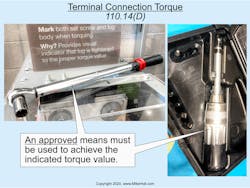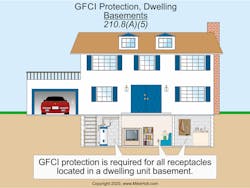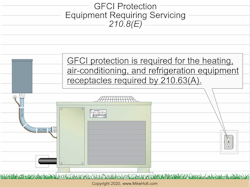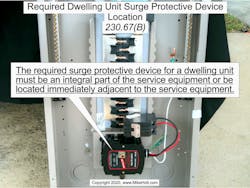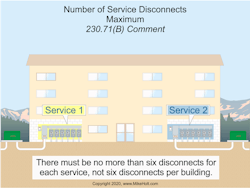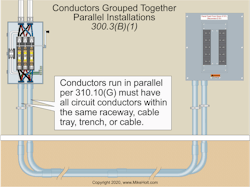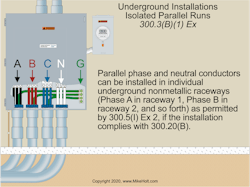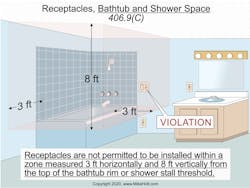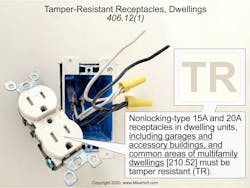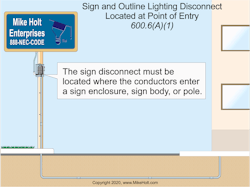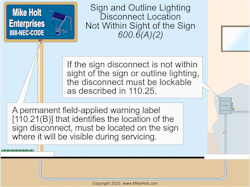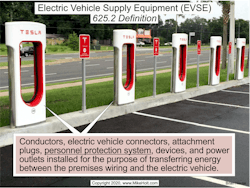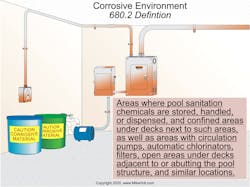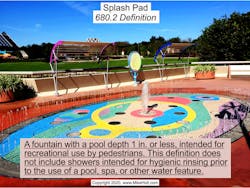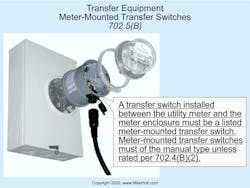As it does every three years, the National Fire Protection Association (NFPA) recently released a new edition of NFPA 70®, National Electrical Code®. The culmination of more than 3,700 public inputs and 1,900 comments (including 1,400 first revisions, more than 600 second revisions, and more than 70 correlating revisions), the 2020 NEC is now available to electrical professionals everywhere. For EC&M readers, this is a monumental time — because we know historically (from ongoing audience participation and feedback) that understanding and applying the NEC is the most important topic we cover.
That’s why we (the EC&M staff), in cooperation with our long-standing NEC Consultant and Code guru, Mike Holt, bring you this special report, in which we break down the key changes to the 2020 edition of the Code that affect the largest number of our readers. It is arguably the most impactful article we publish every three years.
Work your way through this group of 25 revisions — some of which are straightforward in nature and others which may spark industry debate — for a better understanding of the how and why behind each change, thanks to Holt’s commentary. Although they’re not part of our top 25 highlights, the following two new Articles are also worthy of your review.
Article 242 [Overvoltage Protection]
This new Article replaces Art. 280 [Surge Arresters, Over 1,000V] and Art. 285 [Surge-Protective Devices (SPDs), 1,000 Volts or Less]. Part I of this Article provides the general requirements, installation requirements, and connection requirements for overvoltage protection and overvoltage protective devices, (surge protective devices or SPDs). Part II covers SPDs rated 1kV or less that are permanently installed on premises wiring systems. Part III covers surge arresters permanently installed on premises wiring systems over 1kV. These requirements are more appropriately located after Art. 240, since they apply to equipment protection. Article 240 provides rules for protection from overcurrent, and this new Art. 242 contains requirements to provide protection from overvoltage.
Article 800 [General Requirements for Communications Systems]
This Article contains the general rules for the installation of the systems covered by all of Chapter 8, except for Art. 810 [Radio and Television Equipment]. That Article remains standalone from the rest of the Code, including the Chapter 8 Articles. These general rules along with the more specific rules in the respective Articles apply. The specific rules in Articles 805, 820, 830, and 840 supplement or modify the requirements in Art. 800.
Change #1
110.14 Conductor Termination and Splicing
The importance of properly tightened electrical terminations cannot be stressed enough. Loose connections are the cause of far too many service calls, equipment damage, and (worse yet) electrical fires. This rule — addressing the torquing of connections — first appeared in the 2017 NEC. It was revised to require the use of an approved means (not just a calibrated torque tool) to achieve the required torque value. The three new Informational Notes provide guidance for the Code user.
Analysis:
The title of the first level subsection was changed to make the NEC easier to use. Finding termination torque requirements in a rule that is titled “Terminal Connection Torque” is easier than finding the same information in a rule called “Installation.” The previous requirement was for the use of a “calibrated torque tool,” but an approved means could be a torque tool or a fastener with some type of torque indicator.
110.14 Conductor Termination and Splicing
(D) Terminal Connection Torque. Tightening torque values for terminal connections must be as indicated on equipment or installation instructions. An approved means, (torque tool), must be used to achieve the indicated torque value, as shown in Fig. 1 and Fig. 2.
As you read through the analysis on each change, please note that the blue underlined text is NEW to the Code. Although it is slightly reworded or shortened from the actual text in the NEC, it’s a good representation of the intent of the real rule change. Take your time and peruse the following pages for a real-world lesson in NEC application.
Author’s Comment:
• Conductors must terminate in devices that have been properly tightened in accordance with the manufacturer’s torque specifications included with equipment instructions. Failure to torque terminals properly can result in excessive heating of terminals or splicing devices due to a loose connection. A loose connection can also lead to arcing, which increases the heating effect and may also lead to a short circuit or ground fault. Any of these can result in a fire or other failure, including an arc flash event. In addition, this is a violation of 110.3(B), which requires all equipment to be installed in accordance with listing or labeling instructions.
Note 1: Examples of approved means of achieving the indicated torque values include torque tools or devices such as shear bolts or breakaway-style devices with visual indicators that demonstrate the proper torque has been applied.
Note 2: The equipment manufacturer can be contacted if numeric torque values are not indicated on the equipment or if the installation instructions are not available. Annex I of UL Standard 486A-486B, Standard for Safety-Wire Connectors, provides torque values in the absence of manufacturer’s recommendations.
Note 3: Additional information for torquing threaded connections and terminations can be found in Sec. 8.11 of NFPA 70B, Recommended Practice for Electrical Equipment Maintenance.
Author’s Comment:
• Connections are arguably one of the most common points of electrical failure, and properly making those connections is critical in preventing failures. It is difficult to manually find the optimal intersection of mechanical strength and the most desirable performance.
• There is still no guidance as to how often a torquing tool must be calibrated or who is to do so. The revised rule just requires an approved means to achieve the required torque value. This approved means could be a torque tool or a fastener with some type of torque indicator. One such indicator is a double head bolt found on some electrical equipment — where the outer head snaps off at the required torque.
• This rule is still difficult from an enforcement point of view. You may need to try and verify what the AHJ requires. Some may want to be present to watch the torquing of the connection, others may just want to see the tool, and some want to see a “sign off” sheet with the equipment location, the torque value, the date, and the name of the person who torqued the connection. New Informational Notes provide some additional guidance. (See Notes 1, 2, and 3.)
Change #2
110.22 Identification of Disconnecting Means
All electrical circuits, large or small, require a means to turn off the power, and those means are required to be clearly identified. Turning off the wrong circuit(s) can sometimes create havoc! The requirement to identify the
disconnecting means in this rule was expanded to include the source of the circuit that supplies the disconnecting means.
Analysis:
This rule, which requires the disconnecting means to be identified, was expanded to require that the power source, as well as the equipment served, be marked on the disconnect. It does not apply to one- or two-family dwellings.
110.22 Identification of Disconnecting Means
(A) General. Each disconnect must be legibly marked to indicate its purpose unless located and arranged so the purpose is evident. In other than one- or two-family dwellings, the marking must include the identification of the circuit source that supplies the disconnecting means. The marking must be of sufficient durability to withstand the environment involved, as shown in Fig. 3.
Author’s Comment:
• See 408.4 for additional requirements with identification markings on circuit directories for switchboards and panelboards.
• These rules are intended to make it safer to work on electrical equipment. The premise is that if the worker knows the location of the power source, he or she is much more likely than not to lockout and tagout the power source.
Change #3
210.8 GFCI Protection
There is absolutely no doubt that ground-fault circuit-interrupter (GFCI) protection has done more than its fair share of protecting people from the hazards involved with the use of electricity. Each Code cycle increases the emphasis on GFCI protection and the locations in which they are required. With so much attention given to this section, it is inevitable that all circuits in dwelling units will eventually require this protection. The 2020 changes and revisions to this Article are indeed numerous and include clarifications, expansions to existing rules, and a few new additional items. Some items were relocated and placed in their appropriate Articles as indicated in the Informational Notes.
Analysis:
The method of determining the distance from a receptacle has been revised. It now includes paths that pass through doors or doorways. This change was made to address the question as to whether a cabinet door is a door or doorway. With the elimination of any reference to doors, the path through a cabinet door is included in the measurement. In most cases, this means any receptacles installed in the cabinet under a sink must have GFCI protection.
The following is a summary list of the key changes associated with GFCI protection:
210.8(A) Dwelling Units. This was expanded to require GFCI protection for all receptacles rated 125V through 250V supplied by a single-phase branch circuit rated 150V or less to ground in the areas specified in list items (1) through (11). The hazards are related to the location of the receptacle and exist for the higher voltage and higher current receptacles. Things like cord- and plug-connected shop equipment in a dwelling unit garage that operates above 120V, or requires circuits having an ampacity greater than 20A, will now be required to have GFCI protection. The GFCI requirements for protection in dwelling unit basements has been expanded to include both finished and unfinished areas.
210.8(A)(5). List item (5) for basements was expanded to require all basement receptacles to have GFCI protection. Previous editions of the NEC did not require GFCI protection for the finished areas of a basement. The Code-Making Panel felt that conductive floor surfaces may exist in finished and unfinished basements — and that basements (whether finished or unfinished) are prone to moisture and possible flooding, as shown in Fig. 4.
210.8(A)(11). A new list item (11) was added to require all receptacles in an indoor damp or wet location to have GFCI protection. Indoor dog washing areas were cited in the substantiation for this new requirement.
210.8(B) Other Than Dwelling Units. The intent of this rule was corrected for this Code cycle. The 2017 NEC
specified that the GFCI protection rule applied to receptacles having a rating of 150V or less to ground. Receptacles are listed and identified as having nominal or maximum voltage ratings, but their voltage-to-ground ratings are not identified. The revised rule says that GFCI protection is required for all 125V through 250V receptacles supplied by branch circuits with a voltage of 150V or less to ground. Single-phase receptacles require GFCI protection where the supply circuit is rated 50A or less, and for 3-phase receptacles where the supply circuit is rated 100A or less. The locations where GFCI protection is required are found in the 12 list items, two of which are new to the 2020 Code.
210.8(B)(2). This list item now applies to “kitchens or areas with a sink and permanent provisions for either food preparation or cooking.” Places like ice cream parlors, coffee shops, and similar areas present the same shock hazard as areas with kitchens. These places typically do not have stoves or ovens for cooking, so the receptacles were not required to have GFCI protection unless they were located within 6 ft of a sink, as shown in Fig. 5.
210.8(B)(10). This rule was editorially revised to apply to unfinished areas of basements. It previously applied to unfinished “portions.” The wording “not intended as a habitable room” was deleted. The deleted language does not make a technical change in the requirement, and, unlike the change made in 210.8(A)(5) for dwelling unit basements, it was not expanded to include finished areas of non-dwelling unit basements.
210.8(B)(11). The requirement to provide GFCI protection for receptacles installed in laundry areas in non-dwelling occupancies is more closely related to the type of equipment than it is to the type of occupancy. This rule will require GFCI protection for receptacles that service laundry equipment.
210.8(B)(12). List item (12) is new and was added to cover receptacles installed within 6 ft of bathtubs or shower stalls that are not covered by one of the other list items. In non-dwelling occupancies, there may be tubs and showers installed in other than bathrooms and locker rooms.
210.8(C) Crawl Space Lighting Outlets. With the scope change in Art. 555 to include dwelling unit boat docks, the GFCI protection requirement for boat hoists for all occupancies is now found in 555.9, and 210.8(C) is now “Crawl Space Lighting.” The crawl space lighting GFCI requirement was reassigned from (E) to (C) without change, and (E) is now dedicated to a new section, “Equipment Requiring Servicing.”
210.8(D) Specific Appliances. The requirement for outlets that supply dwelling unit dishwashers to have GFCI protection was moved to 422.5(A)(7), and 210.8(D) was repurposed to cover “Specific Appliances.”
210.8(E) Equipment Requiring Servicing. Not all receptacles installed for servicing heating, air-conditioning and refrigeration equipment are installed in locations where other rules would require them to have GFCI protection. This change requires GFCI protection for those receptacles that otherwise would not have such protection. The shock hazard concern is more closely related to the use of portable electric hand tools and cords while servicing the equipment rather than the physical location of the receptacle (Fig. 7).
210.8(F) Outdoor Outlets. This change requires outlets supplying equipment (such as HVAC) to have GFCI protection at dwelling units, and is the result of a fatality where a person contacted a faulty air-conditioning unit with a compromised equipment grounding conductor (EGC). The rules in 210.8(A) address GFCI protection for receptacles. This one addresses GFCI protection for outlets that include hard-wired equipment and was added to address fatalities that have been caused by faulty hard-wired equipment installed at outdoor dwelling unit locations. There is also an exception that says this new rule does not require GFCI protection for lighting outlets other than lighting outlets covered by 210.8(D), as shown in Fig. 8.
Change #4
220.12 Lighting Load for Non-Dwelling Occupancies
This Section now only applies to non-dwelling occupancies, and the lighting load table was revised to more closely conform to the maximum permitted lighting loads as specified in the energy codes. The energy code lighting loads are much less than those found in the NEC, but the Code wants to make sure the services and feeders can still support loads that are not in compliance with the energy codes. The scope was changed to only include lighting loads for non-dwelling occupancies and was reorganized from a single paragraph with exceptions into subdivisions with the previous Exception No. 1 becoming positive text in (B). The new language in (B) made Exception No. 2 unnecessary, and it was deleted.
Analysis:
220.12(A) General. This says that loads not less than those specified in Table 220.12, along with the floor area determination in 220.11, must be used to calculate the minimum non-dwelling occupancy lighting load. New language was added to specify that motors rated 1⁄8 hp or less are considered a general lighting load, and no additional load needs to be added for those motors.
220.12(B) Energy Code. Subdivision (B) is new and recognizes that there are other codes that apply to electrical installations. It also specifically addresses energy codes. Energy codes have been adopted in all 50 states, and they often limit the lighting load to a value much less than what is required by the NEC’s load calculations. This subdivision recognizes those codes and permits the unit values in them to be used in lieu of those found in Table 220.12, provided the conditions as stated are met.
220.12(B) Exception No. 2. This deleted exception only permitted a reduction from the lighting loads shown in Table 220.12 of 1VA per sq ft where the building was designed and constructed in accordance with an adopted energy code for bank and office occupancies. The new language permits the use of the lighting load values from the energy code itself to be used if all four conditions in 220.12(B) are met.
Table 220.12. Some of the occupancies that were included in the previous version of this table are not in the new one. There is a note that cross references the occupancies that do not appear in the new table to those that do. That note also indicates that the 125% multiplier specified in 210.20(A) is included in the unit loads found in Table 220.12. You do not add the 125% to loads calculated using the values in this table, but you must do so if you are using the values from the energy codes as permitted in 220.12(B). The new unit loads are less than the previously required loads but are still in excess of those required by the energy codes (as shown in the Table).
220.12 Lighting Load for Non-Dwelling Occupancies
(A) General. The general lighting load specified in Table 220.12 for non-dwelling occupancies, and the floor area determined in accordance with 220.11, must be used to calculate the minimum lighting load (Fig. 9).
(B) Energy Code. Where the building is designed and constructed to comply with an energy code adopted by the local authority, the lighting load is permitted to be calculated using the unit values specified in the energy code where the following conditions are met:
1) A power monitoring system is installed that will provide continuous information regarding the total general lighting load of the building.
(2) The power monitoring system will be set with alarm values to alert the building owner or manager if the lighting load exceeds the values set by the energy code. Automatic means to act to reduce the connected load is permitted.
(3) The demand factors specified in 220.42 are not applied to the general lighting load.
(4) The continuous load multiplier of 125% is to be applied.
Change #5
230.67 Surge Protection
This new Section requiring the installation of a surge-protective device (SPD) for all dwelling unit services has been a long time coming. Up until now, dwelling unit surge protection has been optional — usually an “extra” for the electrician.
Analysis:
This requirement is being driven by the increasing amount of sensitive electronic equipment found in dwelling units. Electronic life safety equipment — such as fire alarm systems, AFCIs, GFCIs, and smoke alarms, as well as consumer electronic devices, such as computers and TVs — can all be damaged by voltage surges. Studies by NEMA, IEEE, and UL all show that surges cause a significant amount of damage. The text in (B) requires the SPD to be an integral part of the service equipment or located immediately adjacent to that equipment. There is an exception that permits the SPD to be located at the next level downstream distribution equipment.
230.67 Surge Protection
(A) Surge-Protective Device. All services suppling dwelling units must be provided with a surge-protective device.
(B) Location. The surge-protective device must be an integral part of the service disconnect or be located immediately adjacent to the service disconnect, as shown in Fig. 10.
Exception. The surge-protective device is permitted to be located in the downstream panelboard.
Author’s Comment:
An example of where the exception could be applied is where there is an exterior meter main that feeds an interior panel. The SPD could be installed at the interior panel using the exception.
(C) Type. The surge-protective device must be a Type 1 or Type 2 SPD.
(D) Replacement. Where service equipment is replaced, surge protection must be installed.
Change #6
230.71 Number of Service Disconnects
A service is permitted to have only one disconnecting means; however, the number of service disconnects can vary based on the number of disconnects, the grouping, and special circumstances that permit more than one service disconnect.
Analysis:
This is a major change. The new parent language says that each service must have only one disconnecting means unless the requirements of 230.71(B) are met. All the language in (A) that related to the permission to have up to six service disconnects has been deleted. It now just lists the four equipment disconnecting means that are part of listed service equipment but not considered to be service disconnects; this part of the rule is unchanged. Subdivision (B) specifies the conditions under which you are permitted to have more than one service disconnect. The use of two or three single-pole devices with identified handle ties to serve as service disconnects was previously permitted. Each set of single-pole devices that could be operated with a single operation of the hand was considered a single service disconnect. All of that language has been deleted. There are no longer any provisions that permit the use of single-pole devices with handle ties to be used as service disconnects. The new text of (B) allows the use of two to six service disconnects for each service permitted by 230.2, or for each set of service-entrance conductors as permitted by 230.40 Exceptions No. 1, 3, 4, or 5.
230.71 Number of Disconnects
Each service must have only one disconnecting means, except as permitted in 230.71(B).
(A) General. For the purpose of this section, a disconnecting means installed as part of listed equipment and used solely for the following is not considered a service disconnecting means:
(1) Power monitoring equipment
(2) Surge protective devices
(3) Control circuit of the ground-fault protection system
(4) Power-operable service disconnect
Author’s Comment:
A PV disconnect(s) connected to the supply side of a service disconnect is not a service disconnect and is not counted when determining the number of service disconnects [230.82(6)].
(B) Two to Six Service Disconnecting Means. Up to six service disconnects are permitted for each service allowed by 230.2, or for each set of service-entrance conductors permitted by 230.40, Exception No. 1, 3, 4, or 5.
The two to six service disconnecting means may consist of a combination of any of the following:
(1) Separate enclosures with a main service disconnecting means in each enclosure
(2) Panelboards with a main service disconnecting means in each panelboard
(3) Switchboard(s) where there is only one service disconnect in each separate vertical section where there are barriers separating each vertical section
(4) Service disconnects in switchgear or metering centers where each disconnect is located in a separate compartment
Note 2: Examples of separate enclosures with main service disconnecting means in each enclosure include, but are not limited to, motor control centers, fused disconnects, circuit breaker enclosures, and transfer switches that are suitable for use as service equipment.
Author’s Comments:
• The rule is six disconnects for each service — not for each building. If the building has two services, then there can be a total of 12 service disconnects (six disconnects per service), as shown in Fig. 11.
• This revision retains the previous permission to have two to six service disconnects for each service or each set of service-entrance conductors, but provides the increase in safety that a single service disconnect provides. The previous six main disconnect rule for a single enclosure made it impossible to work in service equipment when applying electrical safe work practices in accordance with NFPA 70E, unless the line side of the multi-disconnect enclosure was disconnected by the electric utility.
• This revision also reflects the electrical hazards inherent while working on service equipment where there is more than one service disconnect in a single enclosure. This, combined with the rule in 230.62(C) that requires line side barriers, is a significant safety improvement toward reducing the risk to electricians by limiting their exposure to energized parts.
Change #7
230.85 Emergency Disconnects
One- and two-family dwelling units are now required to have an emergency disconnect installed in a readily accessible exterior location in accordance with 230.85. Finally! Firefighters can now respond to a fully engulfed residence and turn the electricity supply to the building off without fear of the potential of standing in a pool of electrified water (Photo 1).
Change #9
300.3 Conductors
Additional language was added in Sec. (B)(1) to ensure that when connections, taps, or extensions are made from paralleled conductors, each connection involves all the paralleled conductors of each phase and/or neutral.
Analysis:
This is required by the rules in 310.10(H), but the substantiation indicates that many installers and some inspectors may not fully understand those requirements. The panel stated that this change is being made to make it totally clear — where connections are made to a parallel set of conductors, the connection must include all conductors of that phase of the paralleled set.
300.3 Conductors
(B) Circuit Conductors Grouped Together. All conductors of a circuit, including the neutral and equipment grounding conductors must be installed together in the same raceway, cable, trench, cord, or cable tray, except as permitted by (1) through (4).
Author’s Comment:
Keeping all circuit conductors together helps minimize induction, since the individual electromagnetic fields will cancel each other and help maintain the low-impedance ground-fault current path. See 300.5(I).
(1) Paralleled Installations. Conductors installed in parallel in accordance with 310.10(G) must have all circuit conductor sets grouped together within the same raceway, cable tray, trench, or cable, as shown in Fig. 13.
Author’s Comment:
Grouping in sets when paralleling circuits helps minimize the inductive heating of ferrous metal raceways and ferrous metal enclosures for alternating-current circuits. See 250.102(E), 300.3(B), 300.5(I), 300.20(A), 376.20, 378.20, and 392.8(D) for similar requirements.
Connections, taps, or extensions made from paralleled conductors must connect to all conductors of the paralleled set.
Exception: Parallel phase and neutral conductors can be installed in individual underground nonmetallic raceways (Phase A in raceway 1, Phase B in raceway 2, and so forth) as permitted by 300.5(I) Exception No. 2 if the installation complies with 300.20(B), as shown in Fig. 14.
Author’s Comment:
This means that when you tap to just “A” phase and the neutral conductor, the tap connection must include all the conductors of “A” phase and all the conductors of the neutral conductor. Tapping or connecting to less than all the conductors of a paralleled set can result in a current imbalance within that set that may overload one or more of the conductors of the set.
Change #10
406.9 Receptacles in Damp and Wet Locations
The prohibited locations for receptacles in bathrooms has been expanded, and a new exception was added to permit the installation of receptacles in bathrooms that have less space than required in the main text of this Section. There are bathrooms with space limitations that are sized just large enough for the three conventional plumbing fixtures. Unfortunately, bathrooms this small can’t provide the minimum distance requirements. This addition to (C) provides a bit of latitude for the installer.
Analysis:
The language in this Section was revised to be much more specific and restrictive as to the permitted locations of receptacles in bathtub and shower spaces — and prohibits receptacles from being installed within 3 ft horizontally and 8 ft vertically from the top of the bathtub rim or shower stall threshold. This distance matches that in 410.10(D) for luminaires in these same spaces. The previous language only said that the receptacle could not be within or directly over a bathtub or shower stall. This now requires a specific distance from the tub or shower.
The exception recognizes that some bathrooms are just too small to be able to locate the receptacle 3 ft horizontally from the bathtub rim or shower stall threshold. It permits a receptacle to be located opposite the tub or shower on the farthest wall within the room — even where that location is less than 3 ft from the tub rim or shower stall threshold.
406.9 Receptacles in Damp or Wet Locations
(C) Bathtub and Shower Space. Receptacles are not permitted to be installed within a zone measured 3 ft horizontally and 8 ft vertically from the top of the bathtub rim or shower stall threshold. The zone is all-encompassing and includes the space directly over the tub or shower stall, as shown in Fig. 15.
Exception to (C). In bathrooms with less than the required zone, the receptacle(s) are permitted to be installed opposite the bathtub rim or shower stall threshold on the farthest wall within the room.
Change #11
406.12 Tamper-Resistant Receptacles
Four of the existing list items — (1), (2), (4), and (7) in this Section — were modified, and an eighth list item was added.
Analysis:
406.12(1) Dwelling Units. Additional language was added to this list item that applies to dwelling units to make it clear that tamper-resistant (TR) receptacles are required in attached or detached garages, accessory buildings, as well as in the dwelling unit itself. The reference to 210.52 was intended to require the TR receptacles in these areas, but many Code users did not understand that, so specific language was added here.
406.12(2) Guestrooms. The requirement for TR receptacles in hotels and motels was expanded to include common areas. The previous requirement only applied to the receptacles installed in the guest rooms or guest suites.
406.12(4) Preschools. The TR requirement for educational facilities was expanded. The previous rule required TR receptacles in preschool and elementary educational facilities. The word “elementary” was deleted. The deletion of that word now makes the TR requirement apply to high schools, colleges, and universities as well as elementary educational facilities. The substantiation said, “With many facilities being built and used as ‘multi-use,’ it is difficult to determine what age group of student will be utilizing the space. The language would be easier to enforce and not be a debatable issue.” This requirement now applies to all 15A and 20A, 125V and 250V receptacles installed in all locations in all educational facilities.
406.12(7) Dormitory Units. The change in this list item was just from the term “Dormitories” to the defined term of “dormitory units.” There is no change in the actual requirements.
406.12(8) Assisted Living Facilities. This new list item requires that TR receptacles be installed in assisted living facilities. This was added because children may be present at this location when visiting grandparents.
406.12 Tamper-Resistant Receptacles
Nonlocking type 15A and 20A receptacles in the following areas must be tamper resistant “TR”:
(1) Dwelling units, including attached and detached garages and accessory buildings, and common areas of multifamily dwellings specified in 210.52, as shown in Fig. 16.
(2) Hotel and motel guest rooms and guest suites, and their common areas.
(3) Childcare facilities.
(4) Preschools and educational facilities.
Author’s Comment:
In response to a Public Comment to restore the word “elementary” to this Section, the CMP said: “Elementary was removed in the first revision due to the ambiguity as to what age group of children will occupy the space. High school and college facilities also warrant this protection.”
(5) Business offices, corridors, waiting rooms and the like in clinics, medical and dental offices, and outpatient facilities.
(6) Places of awaiting transportation, gymnasiums, skating rinks, and auditoriums.
(7) Dormitory units.
(8) Assisted living facilities.
Exception: Receptacles in the following locations are not required to be tamper resistant.
(1) Receptacles located more than 5½ ft above the floor.
(2) Receptacles that are part of a luminaire or appliance.
(3) A receptacle located within dedicated space for an appliance that in normal use is not easily moved.
(4) Where non-grounding receptacles are installed as permitted in 406.4(D)(2)(a).
Change #12
Part XVI Special Provisions for Horticultural Lighting
A new “Part XVI” was added to Art. 410 that specifically addresses the unique requirements for what are now becoming better known as “grow” facilities (Photo 2).
(2) Drinking water coolers and bottle fill stations.
(3) Cord-and-plug-connected high-pressure spray washing machines.
(4) Tire inflation machines.
(5) Vending machines.
(6) Sump pumps (Fig. 18).
(7) Dishwashers.
Note: Section 210.8 specifies requirements for GFCI protection for the receptacle outlets where the location warrants such protection.
(B) Type and Location. The GFCI must be readily accessible and located in one or more of the following locations:
(1) A GFCI circuit breaker,
(2) A GFCI device or receptacle,
(3) A GFCI integral with the attachment plug,
(4) A GFCI within the supply cord not more than 12 in. from the attachment plug, or
(5) A factory-installed GFCI within the appliance.
Change #14
517.10 Applicability
A new list item (3) was added to subdivision (B) to show additional areas that are not covered by the rules in Part II of Art. 517. AHJs were requiring patient care wiring methods in areas that are not actually patient care areas (Photo 3).
Change #16
555.35 Ground-Fault Protection of Equipment (GFPE) and Ground-Fault Circuit Interrupter (GFCI) Protection
This relocated Section for ground-fault protection (550.3) was divided into two sub-parts: (A) Ground-Fault Protection and (B) Leakage Current Measurement Device. New Informational Notes were also added to both sub-parts (Photo 4).
Analysis:
Equipment that has been previously installed may have been subjected to environments, uses, and conditions that may not be visibly obvious. Approval of that equipment is often difficult and under the purview of the inspecting AHJ.
590.8 Overcurrent Protective Devices
(A) Where Reused. Where overcurrent protective devices that have been previously used are installed in a temporary installation, they must be examined to ensure the devices have been properly installed, properly maintained, and there is no evidence of impending failure.
Note: The phrase “evidence of impending failure” means that there is evidence such as arcing, overheating, loose parts, bound equipment parts, visible damage, or deterioration. The phrase “properly maintained” means that the equipment has been maintained in accordance with the manufacturers’ recommendations and applicable industry codes and standards.
References for manufacturers’ recommendations and applicable industry codes and standards include but are not limited to: NEMA AB 4, Guidelines for Inspection and Preventative Maintenance of Molded-Case Circuit Breakers Used in Commercial and Industrial Applications; NFPA 70B, Recommended Practice for Electrical Equipment Maintenance; NEMA GD, Evaluating Water-Damaged Electrical Equipment; and IEEE 1458, Recommended Practice for the Selection, Field Testing, and Life Expectancy of Molded-Case Circuit Breakers for Industrial Applications.
(B) Service Overcurrent Protective Devices. Overcurrent protective devices for 277/480V services must be of the current-limiting type.
Change #18
600.6 Disconnecting Means
This rule was revised to say that conductors passing through a sign — and are not disconnected by the sign disconnect — must be inaccessible to service personnel. Many types of sign designs allow for or make available wiring chases for other circuits to pass through. This practice is a cost-effective and convenient way to minimize additional wiring methods that would need to be installed to serve the same purpose. Subdivision (A)(4) requires that there be firefighter access to sign disconnects and that they may be located away from the sign.
Analysis:
600.6(A) Disconnect Location, (1) At Point of Entry to a Sign, Exceptions 1 and 2. These exceptions were revised to clarify that the sign disconnect is not required to disconnect feeder or branch circuit conductors that are installed in a Chapter 3 wiring method where those conductors are not accessible. This change is intended to address the problem of accessible energized conductors within the sign after the sign disconnect has been placed in the off position. New subdivision (A)(4) requires a remote sign disconnect to be installed in a location that is readily accessible to firefighters and clearly marked to identify what the disconnect controls.
600.6(A)(4) Remote Location. This is a new second level subdivision that addresses firefighter access to remotely located disconnects. The disconnecting means is permitted to be located at the sign or controller or remotely so long as local control by first responders is provided.
600.6 Disconnecting Means
(A) Disconnect Location
The sign disconnect is permitted to be located as follows:
(1) At the Point of Entrance to a Sign. The sign disconnect must be located where the conductors enter a sign enclosure, sign body, or pole (Fig. 20).
Exception No. 1: A sign disconnect is not required to be located at the point the conductors enter a sign enclosure or sign body for conductors that pass through a sign where not accessible and enclosed in a Chapter 3 raceway or metal jacketed cable.
Exception No. 2: A sign disconnect is not required to be located at the point the conductors enter a sign enclosure or sign body for a feeder that supplies a panelboard located within the sign under the following conditions: The feeder conductors must be enclosed where not accessible in a Chapter 3 raceway or metal jacketed cable, a permanent field-applied warning label having sufficient durability to withstand the environment involved, complying with 110.21(B), and visible during servicing is applied to the raceway or metal cable at or near the point of the feeder circuit conductor’s entry into the sign enclosure or sign body and the warning label reads:
DANGER. THIS RACEWAY CONTAINS ENERGIZED CONDUCTORS.
The warning label must identify the location of the sign disconnect and the it must be capable of being locked in the open position with provisions for locking to remain in place whether the lock is installed or not [110.25].
Author’s Comment:
This rule now requires that any pass-through conductors not controlled by the sign disconnect be closed in an approved wiring method that does not include accessible points such as conduit bodies or junction boxes. Conductors run in conduit bodies and junction boxes are considered to be accessible.
(2) Within Sight of the Sign. The sign disconnect must be within sight of the sign or outline lighting system it controls.
If the sign disconnect is not within sight of the sign or outline lighting, the disconnect must be capable of being locked in the open position with provisions for locking to remain in place whether the lock is installed or not [110.25]. A permanent field-applied warning label, having sufficient durability to withstand the environment involved and complying with 110.21(B) that identifies the location of the sign disconnect, must be located on the sign where it will be visible during servicing (Fig. 21).
(3) Controller Disconnect as Sign Disconnect. Signs or outline lighting systems operated by controllers located external to the sign or outline lighting system must have a disconnect for the sign controller in accordance with the following:
(1) The controller disconnect must be located within sight of or within the controller enclosure.
(2) The controller disconnect must disconnect the sign or outline lighting and the controller from all phase conductors.
3) The controller disconnect must be capable of being locked in the open position with provisions for locking to remain in place whether the lock is installed or not [110.25].
Exception: Where the controller disconnect is not within sight of the controller, a permanent field-applied warning label, having sufficient durability to withstand the environment involved and in accordance with 110.21(B) that identifies the location of the sign disconnect, must be located on the sign where it can be visible during servicing.
(4) Remote Location. The disconnecting means, if located remote from the sign, sign body, or pole, must be mounted at an accessible location available to first responders and service personnel. The location of the disconnect must be marked with a label at the sign location and marked as the disconnect for the sign or outline lighting system. The label must be permanent, field applied, have sufficient durability to withstand the environment involved, and be in accordance with 110.21(B).
Change #19
625.1 Scope
Both the title and scope of this Article were changed to include systems that permit bidirectional current flow of electricity. A battery energy storage system (ESS) is permitted to supply premises demand for electricity, when necessary, and the rules for this are covered here in Art. 625.
625.2 Definitions
Along with a new definition comes the new acronym EVPE, which stands for electrical vehicle power export equipment. As with any alternate source of electrical power, exporting power from electric vehicles presents the same concerns when transferring from normal power to stand-by power. Perhaps this played a role in the clarification(s) made in the definition and yet another acronym — EVSE or electric vehicle supply equipment — which includes personnel protection considerations. Some electric vehicles can supply electrical loads external to the vehicle, and this definition covers the equipment that might be necessary to provide this function.
Analysis:
Several other changes in the Article permit the use of equipment with bidirectional current flow. What does this mean? Simply put, the batteries in the vehicle can be either charged from or supply power to the building electrical system. This Article covers the electrical conductors and equipment that connect to premises wiring for the purposes of charging, power export, or bidirectional current flow.
Electric Vehicle Power Export Equipment (EVPE). This is the equipment, including the outlet on the vehicle, that is used to provide electrical power (greater than or equal to 30VAC or 60VDC) to external loads using the vehicle as the source of supply. A new informational note was added to indicate that the EVPE equipment and the electric vehicle supply equipment may be contained in a single piece of equipment that is sometimes called bidirectional EVSE (Electric Vehicle Supply Equipment).
Electric Vehicle Supply Equipment (EVSE). The acronym EVSE was added to the term title, and the definition was revised. The acronym is used in the text of the Article, but was not shown in this definition in the previous Code. The revision says that the EVSE includes a personnel protection system installed specifically for transferring energy between the premises wiring system and the electric vehicle. Items include, but are not limited to, neutral, phase, equipment grounding conductors, electric vehicle connectors, other fittings, devices, power outlets, and/or apparatus of the EVSE required by 625.22. An informational note was added that says electric vehicle power export equipment and electric vehicle supply equipment are sometimes contained in one piece of equipment and may be referred to as bidirectional EVSE.
625.1 Scope
Article 625 covers the installation of conductors and equipment connecting an electric vehicle to premises wiring for the purposes of charging, power export, or bidirectional current flow, as shown in Photo 6.
625.2 Definitions
The following definitions only apply within this article.
Electric Vehicle Power Export Equipment (EVPE). The equipment, including the outlet on the vehicle, that is used to provide electrical power at voltages greater than or equal to 30VAC or 60VDC to loads external to the vehicle as the source of supply.
Note: Electric vehicle power export equipment and electric vehicle supply equipment are sometimes contained in one piece of equipment, referred to as a bidirectional EVSE.
Electric Vehicle Supply (EVSE) Equipment. Conductors, electric vehicle connectors, attachment plugs, personnel protection system, devices, and power outlets installed for the purpose of transferring energy between the premises wiring and the electric vehicle, as shown in Photo 7.
Note: Electric vehicle power export equipment and electric vehicle supply equipment are occasionally contained in one piece of equipment, sometimes referred to as a bidirectional EVSE.
Wireless Power Transfer Equipment (WPTE). Equipment consisting of a charger power converter and a primary pad. The two devices are either separate units or they are contained within a single enclosure.
Change #20
680.2 Definitions
There were several new terms added this Code cycle, an important relocation, and an Informational Note pertaining to corrosive environments. The term “Fountain” was updated to include “Splash Pads” in its definition, and the term “Immersion Pool” was added as well.
Analysis:
Corrosive Environment. This was previously defined in 680.14(A). It has been relocated with clarifications and a new Informational Note, which provides additional information about the corrosion hazard. The previous text was considered as being overly broad in scope. The Informational Note provides additional guidance as to what a corrosive environment is. Sanitation chemicals and pool water are considered to pose a risk of corrosion due to the presence of oxidizers. The note lists three sources where additional information may be found.
Fountain. The term fountain now also includes “splash pads.” A splash pad is a special type of fountain, and we will see a new definition for that term as well.
Immersion Pool. This is a new definition that is being added to clarify what an immersion pool is for the application of two new Sections (680.35 for storable immersion pools and 680.45 for permanently installed immersion pool). It is simply a pool used for ceremonial or ritual immersion of users and is designed and intended to have its contents drained or discharged. There are potential safety hazards related to electricity with immersion pools just as there are with bathtubs or pools.
Splash Pad. The term “splash pad” was added to the definition of fountain so all the requirements for fountains also apply to splash pads. The definition does not include showers intended for hygienic rinsing prior to the use of a water feature. Splash pads are a common feature in many public areas, and this will help to ensure that the electrical systems for splash pads are safely installed.
680.2 Definitions
The definitions in this Section apply only within this Article.
Corrosive Environment. Areas where pool sanitation chemicals are stored, handled, or dispensed, and confined areas under decks adjacent to such areas, as well as areas with circulation pumps, automatic chlorinators, filters, open areas under decks adjacent to or abutting the pool structure, and similar locations, as shown in Fig. 22.
Note: Sanitation chemicals and pool water are considered to pose a risk of corrosion (gradually damaging or destroying materials) due to the presence of oxidizers (for example, calcium hypochlorite, sodium hypochlorite, bromine, and chlorinated isocyanurates) and chlorinating agents that release chlorine when dissolved in water. More information about swimming pool chemicals can be found on or in
the following:
(1) Environmental Protection Agency website
(2) NFPA 400, Code for the Storage of Liquid and Solid Oxidizers
(3) Advisory: Swimming Pool Chemicals: Chlorine, OSWER 90-008.1, available from the EPA National Service Center for Environmental Publications (NSCEP)
Author’s Comment:
This seems overly broad, especially to require areas where these chemicals are stored in their dry form and away from water sources, to be considered a corrosive environment.
Fountain. An ornamental structure or recreational water feature from which one or more jets or streams of water are discharged into the air, including splash pads, ornamental pools, display pools, and reflection pools. The definition does not include drinking water fountains or water coolers.
Immersion Pool. A pool for ceremonial or ritual immersion of users, which is designed and intended to have its contents drained or discharged.
Splash Pad. A fountain with a pool depth 1 in. or less, intended for recreational use by pedestrians. This definition does not include showers intended for hygienic rinsing prior to use of a pool, spa, or other water feature, as shown in Fig. 23.
Analysis:
695.6(A)(1) Services and On-Site Power Production Facilities, Exception. This rule requires that these conductors be physically routed outside of the building and be installed as service entrance conductors in compliance with 230.6, 230.9 and Parts III and IV of Art. 230. A new Exception was added to say that supply conductors within the fire pump room are not required to be installed in accordance with 230.6(1) or (2). The PI indicated that the fire pump room itself is required to be 2-hour rated and protected by a fire sprinkler system so that there is no need for additional protection for the supply conductors within the fire pump room itself. This also makes the Code more consistent, as the fire pump motor conductors installed between the fire pump controller were not required to be treated like service conductors within the fire pump room.
695.6(A)(1) Informational Note. The fire pump controller is often service equipment, and the fire pump is a 3-phase load that does not require a grounded conductor. The rule in 250.24(C) that requires the grounded conductor be run to the service equipment was being missed by some designers and installers. This note calls attention to that requirement.
695.6 Power Wiring
(A) Supply Conductors.
(1) Services and On-Site Power Production Facilities. Service conductors and conductors supplied by on-site power production facilities must be physically routed outside buildings. Where supply conductors are run inside the building, they must be encased in 2 in. of concrete or brick [230.6].
Exception: Supply conductors within the fire pump room are not required to be encased in 2 in. of concrete or brick as required by 230.6(1) or (2).
Change #25
702.5 Transfer Equipment
This rule was broken up into four subsections, one of which is a new rule [702.5(B)] added to permit the use of meter-mounted transfer switches.
Analysis:
This new paragraph was added to address the use of meter-mounted transfer switches. Unlike Art. 700 and Art. 701 — where the use of such transfer switches is prohibited — they are permitted for use for optional standby systems. These switches are required to be manual transfer switches unless they meet the requirements for automatic transfer switches found in 702.4(B)(2). The listing standard, UL1008M, provides for either manual or automatic transfer switches. The manual type is typically designed for a cord connection between the meter-mounted transfer switch. In many cases, these devices will be installed and owned by the electric utility, and customers will see a monthly rental charge on their electric bill for the meter-mounted transfer switch. This device greatly simplifies the installation of a dwelling unit optional standby system.
702.5 Transfer Equipment
(A) General. Transfer equipment (manual or automatic) is required for all standby systems and is subject to the requirements of this article and for which an electric utility supply is either the normal or standby source. Transfer switches are not permitted to be reconditioned.
Exception: Temporary connection of a portable generator without transfer equipment is permitted where conditions of maintenance and supervision ensure that only qualified persons will service the installation, and where the normal supply is physically isolated by a lockable disconnect or by the disconnection of the normal supply conductors.
(B) Meter-Mounted Transfer Switches. A transfer switch installed between the utility meter and the meter enclosure must be a listed meter-mounted transfer switch. Meter-mounted transfer switches must be of the manual type unless rated in accordance with 702.4(B)(2), as shown in Fig. 25.
(C) Documentation. In other than dwelling units, the short-circuit current rating of the transfer equipment must be field marked on the exterior of the transfer equipment.
(D) Inadvertent Interconnection.
Transfer equipment must be suitable for the intended use and listed, designed, and installed so as to prevent the inadvertent interconnection of all sources of supply in any operation of the transfer equipment.
Author’s Comment:
Although there are listed breaker interlock kits, verifying that these are listed as transfer equipment is another story. This new listing requirement will require an interlock kit to be listed as transfer equipment. It is evident that the panel’s intent is to prohibit the use of ordinary breaker interlock kits (as they can be defeated by the removal of the panel cover) to avoid the danger of both the optional standby breaker and the normal supply breaker being placed in the on position. While the Code text does not say anything about the removal of covers defeating the transfer equipment interlock, breaker interlocks listed as “transfer equipment” satisfy the Code-Making Panel’s intent.
These materials are provided to us by Mike Holt Enterprises of Leesburg, Fla. To view additional Code training materials offered by this company, visit www.mikeholt.com.
About the Author

Mike Holt
Mike Holt is the owner of Mike Holt Enterprises (www.MikeHolt.com), one of the largest electrical publishers in the United States. He earned a master's degree in the Business Administration Program (MBA) from the University of Miami. He earned his reputation as a National Electrical Code (NEC) expert by working his way up through the electrical trade. Formally a construction editor for two different trade publications, Mike started his career as an apprentice electrician and eventually became a master electrician, an electrical inspector, a contractor, and an educator. Mike has taught more than 1,000 classes on 30 different electrical-related subjects — ranging from alarm installations to exam preparation and voltage drop calculations. He continues to produce seminars, videos, books, and online training for the trade as well as contribute monthly Code content to EC&M magazine.


